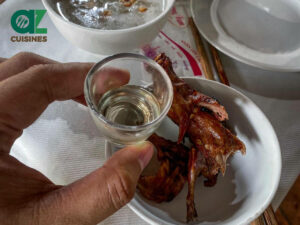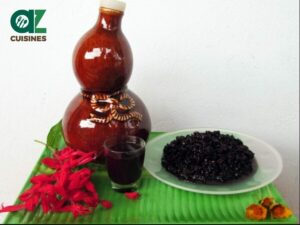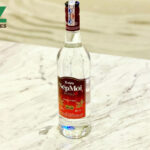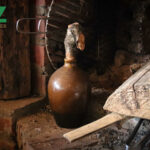#8 in Vietnam
Rượu: Ingredients and Preparation
Main Ingredients
Main Preparing Method
Preparation Process
Rượu: A Deep Dive
Cultural Significance
Taste
Texture
Aroma
Color
Serving Style
Serving Temperature
Accompaniment
Occasions
Calories
Popularity
Popular Similar Drinks
- Soju
- Sake
- Baijiu
- Mijiu
- Arrack
Popular Dining Area
Rượu refers to a group of alcohol in Vietnam, like spirits or wine (except beer). Depending on ingredients and methods, rượu is available in different types and names. In Vietnam, they also vary based on regions across the country.
Rượu is typically made by fermenting rice or other grains, fruits, or even flowers. Many Vietnamese-style rượu is made from rice, like rượu đế, rượu nếp, rượu cần, etc. Rượu made from fruits, typically grapes, is called rượu vang.
Rượu is a favorite drink in Vietnam. Alcohol consumption in Vietnam is notably high. According to the World Health Organization (WHO), the consumption rate is overwhelmingly dominated by beer, which accounts for 91.5% of all alcoholic drinks consumed, followed by spirits at 7.7% and 0.8% for wine.
It anticipates that by 2025, Vietnam will become the largest per capita consumer of alcoholic drinks in Asia and rank 25th globally, with an expected average consumption of 11.4 liters of alcohol per person per year.
Vietnam’s rượu boasts a rich array of types, each with unique characteristics and tastes. Grasping the pros and cons of rượu is crucial. Also, explore the FAQs for deeper insights into these Vietnamese spirits and their global counterparts. And all of this interesting information will be shown in the following sections. Keep scrolling!
Key Points
Rượu Images
What Are Popular Vietnamese Types of Rượu?
Here, you’ll explore the diversity of Vietnamese rượu, where each type offers its unique character. Check out the table for more details.

Rượu Đế
Traditional distilled liquor made from glutinous or non-glutinous rice in Vietnam; strong and clear.

Rượu Nếp
From northern Vietnam; made from glutinous rice; mild alcohol.

Rượu Cần
Also known as straw liquor, enjoyed through bamboo straws; made from glutinous rice; popular in ethnic groups in areas such as Tay Nguyen or Tay Bac.

Rượu Vang
Vietnamese wine made from grapes, varies from red to white.

Rượu Bầu Đá
Named after the water source used in fermentation and distillation, ‘Bàu đá’. High alcohol content, over 50%.

Rượu Chuối Hột
An alcoholic beverage infused with a fruit of Musa barjoo (referred to as “chuối hột” in Vietnamese); many use this liquor for medicinal purposes.

Rượu Dừa
Made from either the fruit or the flower of the coconut; normally fermented in a whole coconut; very popular in Ben Tre Province.

Rượu Rắn
Also known as snake wine, infused with whole snakes.

Rượu Đế Gò Đen
Made from rice or glutinous rice using traditional methods. Notably high in alcohol content, up to 50%.

Rượu Nếp Cẩm
Made from purple glutinous rice; rich in color and taste.

Rượu Nếp Than
A liquor from the Mekong Delta region, made from black glutinous rice; has a red-brown or purplish color.
After learning about the popular types of rượu in Vietnam, let’s consider their advantages and disadvantages.
Pros and Cons of Drinking Rượu
To gain a balanced understanding of rượu, it’s essential to consider its benefits and drawbacks with the table below.
Pros
Cons
Now, let’s turn your attention to some frequently asked questions about rượu to clarify any further curiosities.


























Adam Sam
Senior Food and Drink Editor
Expertise
Food Writer & Recipe Developer, Recipe Tester, Bartender, Cooking-video Maker, Editor In Chief
Education
Adam Sam, an experienced food writer and recipe developer, is passionate about blending diverse culinary traditions, national dishes, and innovative beverages, showcasing his proficiency in both traditional and modern recipe testing.
As the Editor-in-Chief, he elevates culinary content from street food to fine dining, focusing on Western cuisine and types of drinks at azcuisines.com, and is professional in creating engaging cooking videos that simplify complex dishes and ingredients.
His passion for food is evident in his writing, where he uniquely merges various cultures, traditions, and contemporary trends, skillfully combining classic recipes with modern cooking methods.